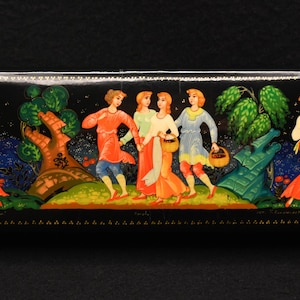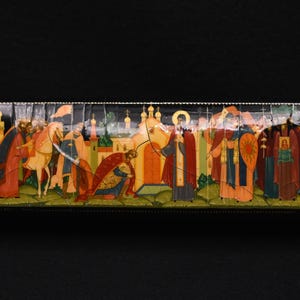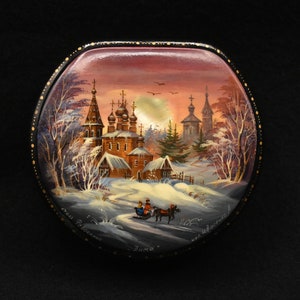


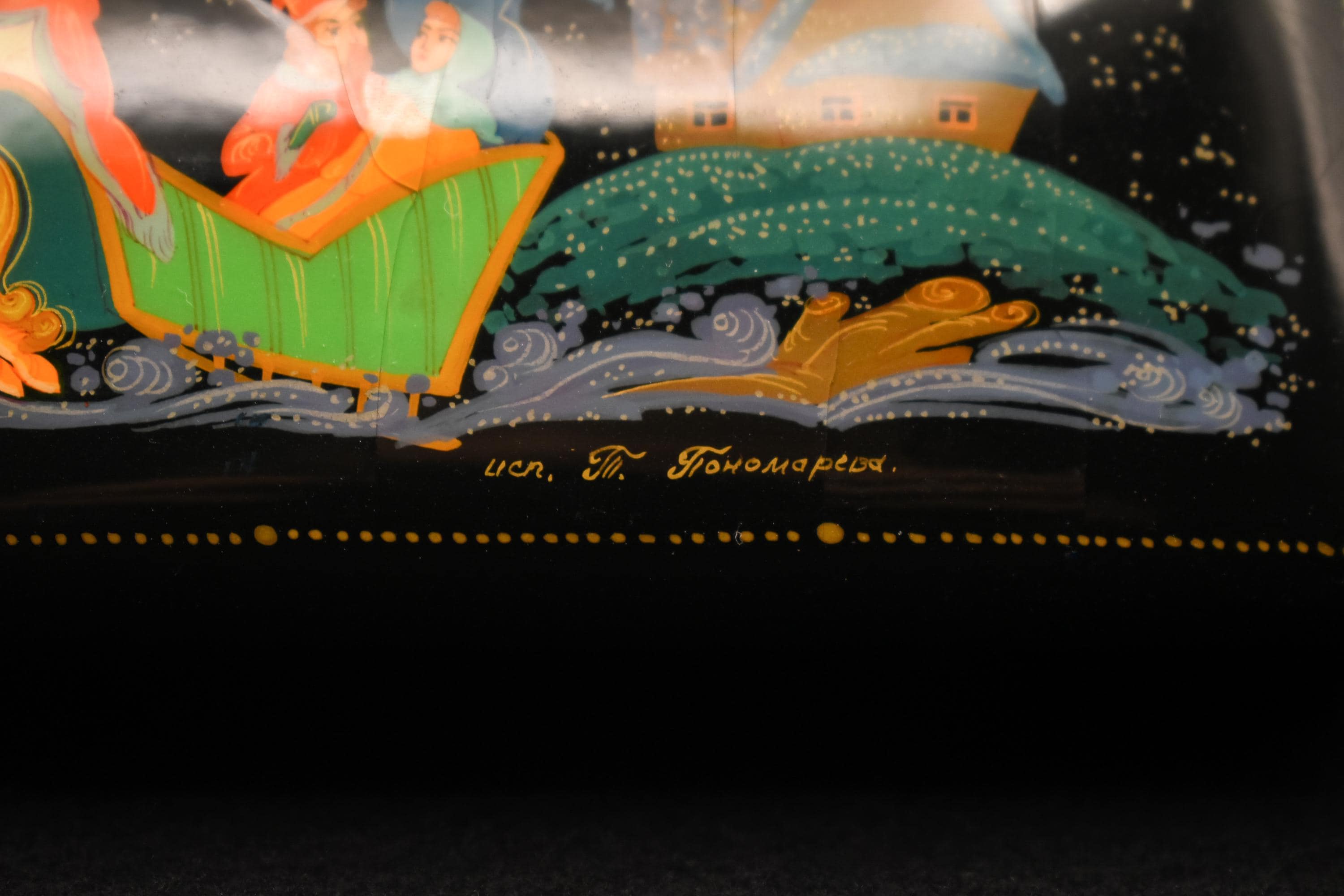
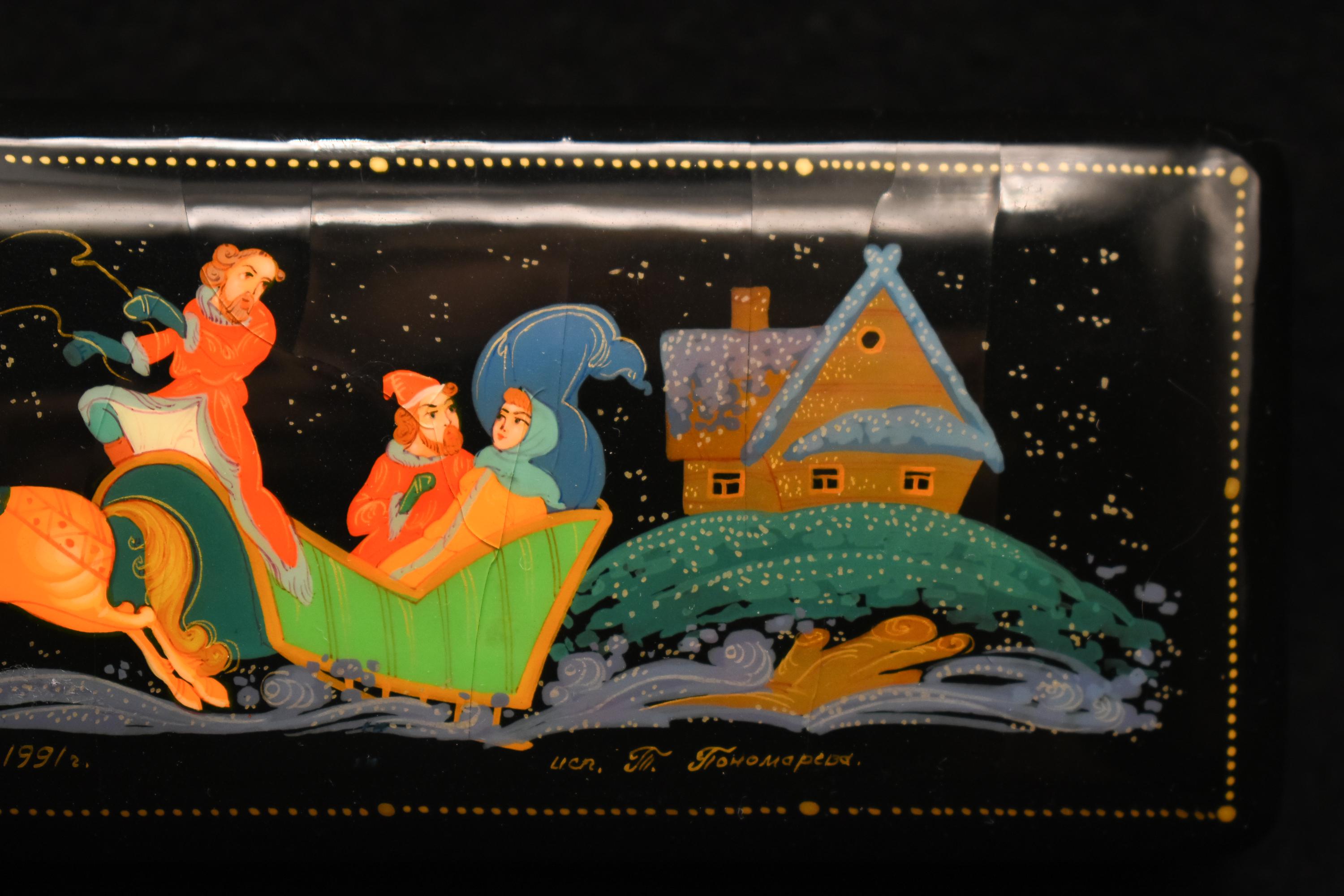
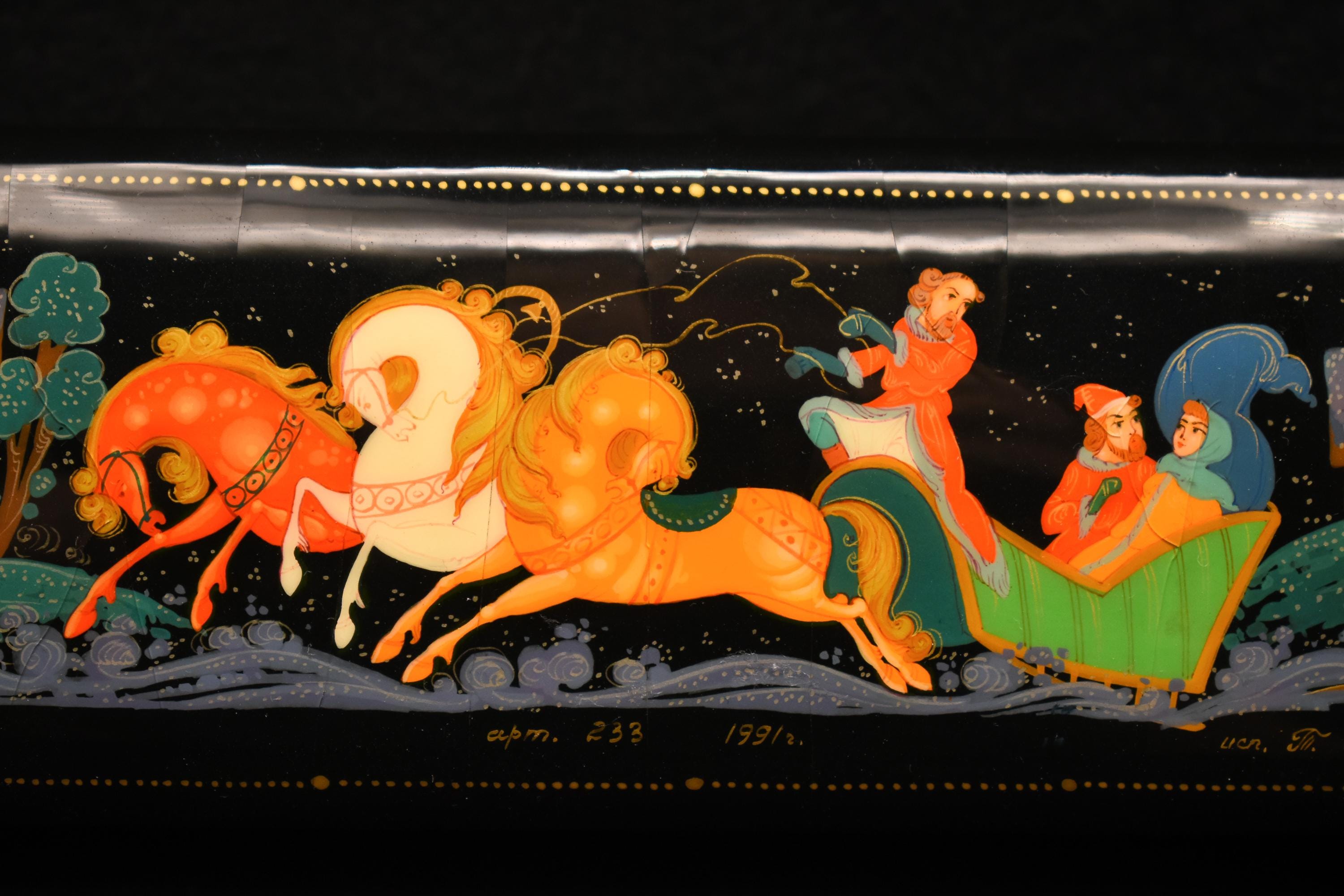
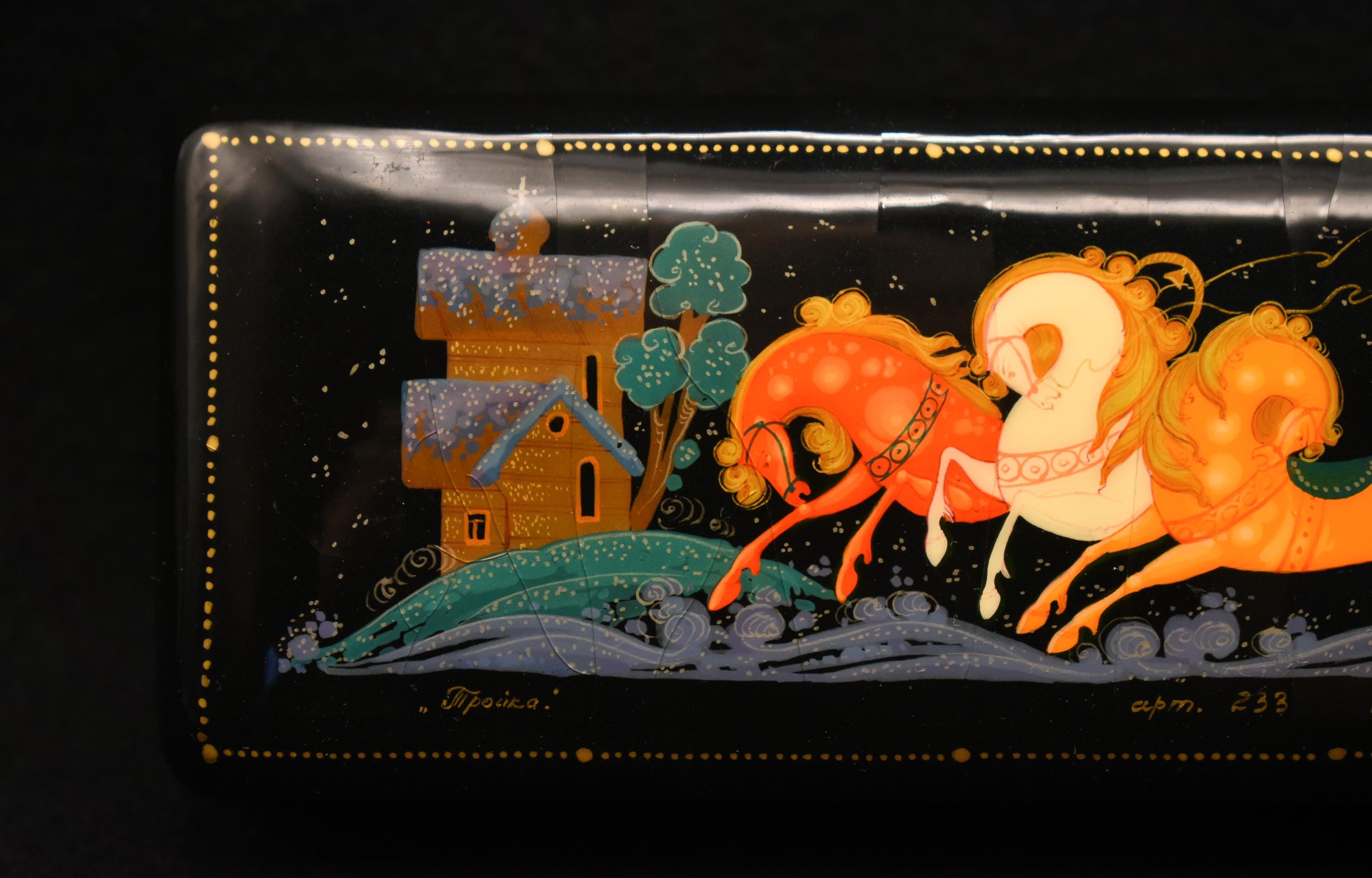
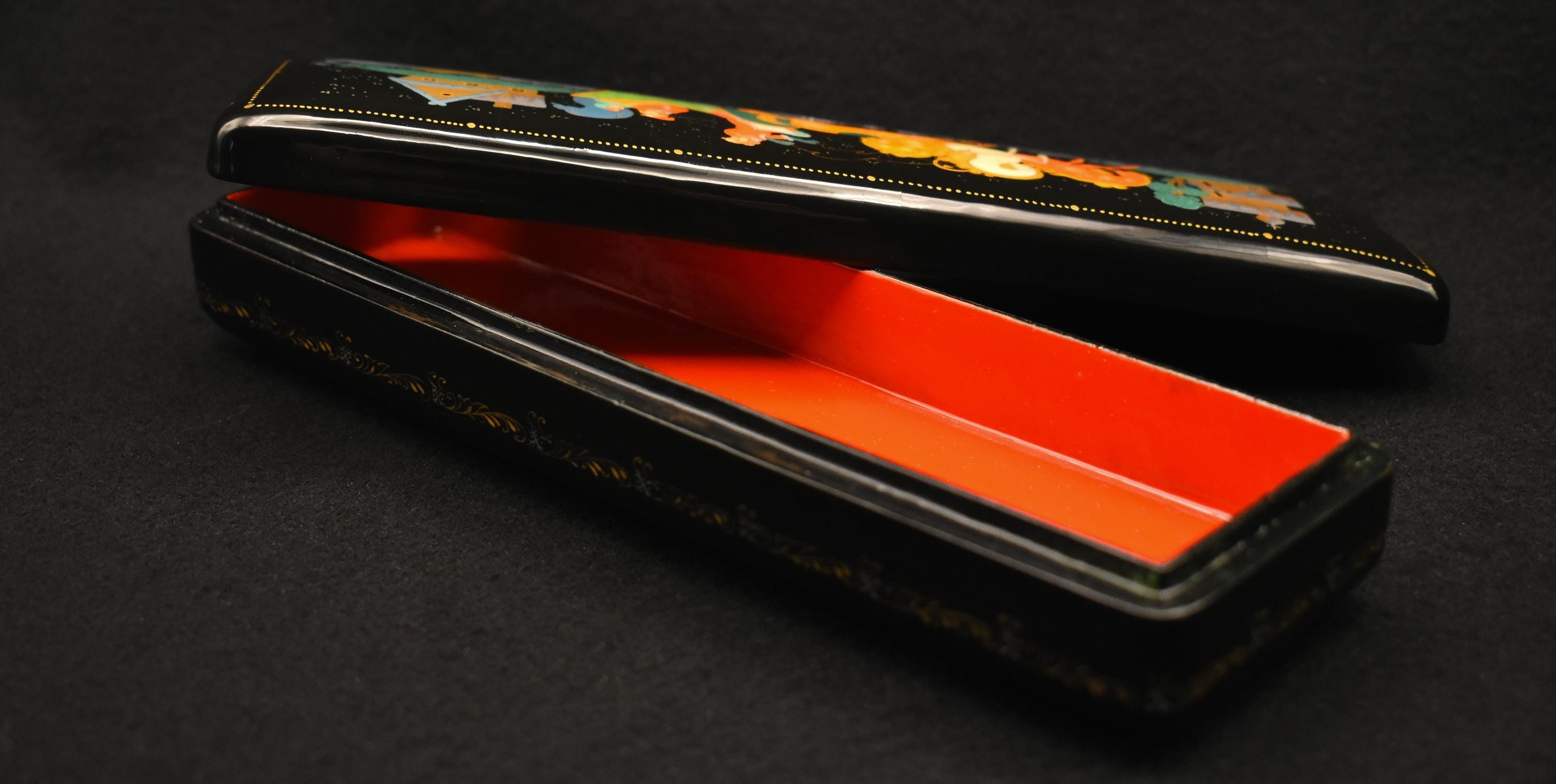
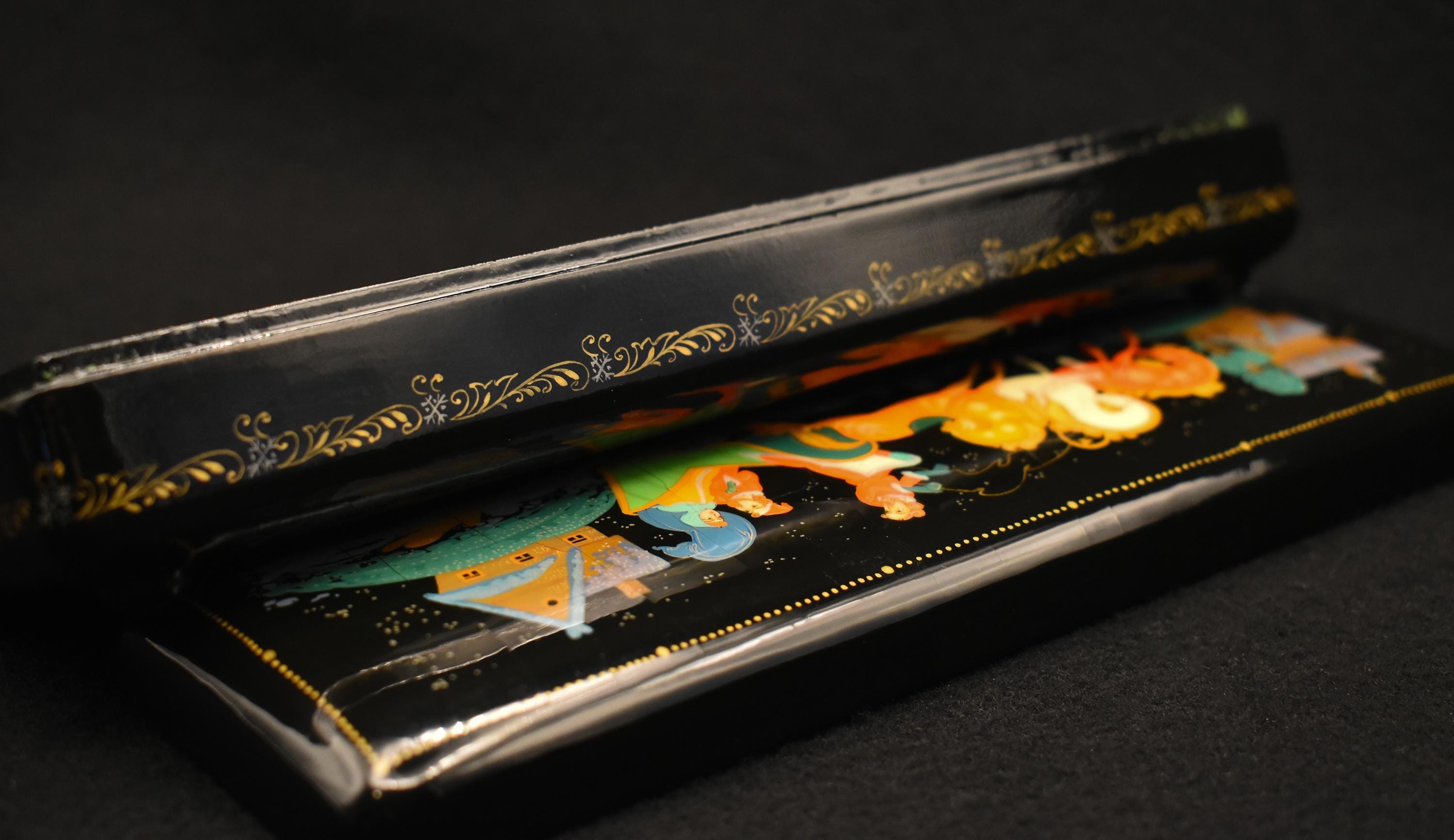

Prints and Art
Stunning Vintage Russian Lacquer Box - ever-so-slightly imperfect
$174.33
-
DetailsPlease note -TARIFFS PAID! US buyers need not worry about any additional charges! Order with confidence, knowing you won't be surprised with any additional fees.
Although the following history is the same as the other Lacquer Boxes in my store, scroll down to the paragraph break for product-specific description.
Some of you might be familiar with these stunning Russian boxes, but few know the story of their origins. It actually began over 200 years ago...
Miniature lacquer painting began in the village of Danilkovo (now Fedoskino), near Moscow. Artists began developing the techniques that would spawn Russian lacquer boxes in the late 1600s, cutting their teeth in the realm of religious art. Danilkovo was the center of the art of creating religious icons (highly-sought-after paintings of religious symbols and characters). Having developed some truly breathtaking painting techniques (including using liquified precious metals such as gold and silver, and painting with a single hair follicle, resulting in some of the most spectacular detail many had ever seen), it was the natural birthplace of these stunningly intricate boxes. Within 50 years, 3 other villages would join the guild of artists, becoming famous the world over for some truly staggering art. Each town, Fedoskino, Palekh, Kholuy and Mstera had a lengthy history, with regards to iconography and elite artistic creations, so they were natural destinations for the artistic communities that would grow around the Russian capital. As time progressed, each town and their respective artists formed specialized and very selective schools to disseminate their skills, and as such, developed their own style. Although the revolution of 1917 damaged not only the desirability but even legality of the religious subject matter of many of these artists and their craft, they persisted to keep their crafts alive. They survived the oppression of much of the 20th century and even began to flourish again, in the last half of the 20th century. Even today, these schools are formed of the most elite and talented painters in the country, although the majority of the most amazing pieces are created by artistic descendants, going back up 5 generations! Their creations are infinitely impressive in the application of these stunning pigments and details, much as their parents and grandparents before them.
Starting in the 1800s, these boxes were made specifically of a papier-mâché base. Each would take approximately 6 weeks to complete and would include a base of linseed oil, rendering it impervious to moisture. This method also ensured a stable base that would not warp and does not change size due to temperature changes or fluctuations in humidity. Only once completed and approved by a master, the painting process would begin. First, it passes through the hands of an apprentice who ensures a smooth base of colour - the interior is painted bright red and the exterior a deep black. When the master painters get their hands on these pieces is when the magic truly begins. Using a magnifying glass, in many cases, and the richest and brightest oil-based pigments available, the master painter applied the stunning colours and textures you see here. You might be drawn to the glittering of the border or the signature along the bottom. However, this application of pigments made of true 24 kt gold and pure silver is visible throughout the piece. Because the 4 towns specialized in their own methods and styles, one can tell apart the pieces based on their colours and textures, the subject matter within, as well as the methods of applying their magnificent pigments.
These 4 towns still produce these stunning pieces today, although after the fall of the USSR in 1991, their quality waned. The popularity of these boxes skyrocketed with international recognition and, naturally and most-unfortunately, this resulted in a veritable flood of counterfeits and fakes. Luckily, manufacturers of fake pieces are not patient, so the box itself doesn't go through the rigours of proper papier-mâché manufacture. The fakes are made of plastic or resin, so they're easily identified. Firstly, one could find a slight grid pattern on the base, indicating a machine-made box. The linseed oil base would start to settle after 6 months or so, releasing a distinct odour, so the interior has a definite 'antique' smell to it, nearly impossible to replicate with a resin box. The weight of the fake boxes would be significantly heavier, as well - papier-mâché is very light. The texture of the box would easily reveal the content, as well. One must simply tap or flick the bottom of the box. If there's a sharp sound or a click, it's not the genuine article. Papier-mâché boxes sound muted, almost soft, when tapped. Lastly and most-importantly, we must examine the image itself. Is there the depth that comes with layers of meticulous application of lacquer? A magnifying glass is very useful in finding these imperfections and identifying a fake. Normally, I rely on artist signature and information that is legible, but early boxes (especially created by masters) rarely featured legible signatures. As such, we must frequently examine further. What about the colours and pigments used? The colour of the box, under intense LED light, shows a slight green pigment to the black portions of the box, with gold elements showing through. This is a known denaturing of colours, especially if the piece suffered some neglect (apparent from frequently-cracking lacquer), so that gives us yet more information as to the legitimacy of any given piece. The detail and brush-strokes are just staggering - impossibly minute details and pigment-mixtures show meticulous detail, but we must be wary of counterfeit items. My evidence of authenticity, however, is found in a most unusual place. See, the condition of our box is sadly wanting... the last half-century has not treated this piece with much respect (more on this later). Fakes are not uncommon, but with these fakes, it is very obvious to see a 'sticker' that is placed onto a plastic box, representing the purported painted image. Any cracks to the lacquer make this sticker stand out, painfully. Firstly, this is not a plastic box - the texture and sound indicate genuine Fedoskino/Kholui/Mstera/Palekh papier-mâché, and it would be exceedingly unlikely that a fake item would use a genuine papier-mâché box. Further, under magnification, the edges are beautifully untidy - along almost the entire edge of the image, one can see the impossibly intricate brush strokes that are the limits of the image. The authenticity of this particular piece (as well as all the others you'll find at C&K) can not be disputed, however. You see, this piece was imported by my grandfather almost 40 years ago. In the 80s and early-90s, he owned a Russian Art and Toy Store in West Edmonton Mall. He successfully ran his store for several decades, but his stock wasn't ordered or shipped-in. Every other year, as a former citizen of the Soviet Union, (he immigrated with his/my family in the early-70s) he would take a trip to Russia. He was aware of these staggering pieces of art and would do so specifically to visit these towns firsthand, purchase, pack and import these pieces, himself. Over the years, he formed some very close friendships with these artists, watching their children take up their parents' posts and inheriting their remarkable talents. He would bring only 2 or 3 changes of clothes, but brought no fewer than 4 full-size suitcases, brimming with simple gifts for these remarkably talented families who were practicing under a brutal Soviet regime. When he brought these crafted riches home, it would be quite an event, unpacking the treasures and marveling at their colours while he and my grandmother regaled me with the tales of their subjects... Sadly, he passed away last year. Although I have kept a great deal of his stunning pieces, I am simply inundated with the vast quantity of boxes he has left me. As such, I have decided to offer them for sale.
The artistic merit of the piece is no longer in question, nor are the origins of this stunning, lidded box, but what is the picture?
The piece is titled 'Troika.' This, translated, simply means 'Trio.' This refers not to the people in the horse-drawn sleigh, but to the horses. Throughout Russian history, a trio of horses pulling your carriage, not to mention the hired coachman, was a show of immense wealth. Only the elite were privy to such luxuries, as common folk were limited to simple carriages, pulled by a single horse and very infrequently accompanied by a coachman. The artist has shown, with beautiful clarity, the magnificence of the beasts before this particular carriage. The colours and shading used may not be realistic, but they are nonetheless staggeringly beautiful. The flanking horses are orange and red with cream accents and beautifully coiffed manes, curling and flowing about their admirable bodies. The center horse is a beautiful cream, much adored by the Russian gentry. The coachman is respectfully clad in a beautiful red cossack and what look to be thick, blue mitts. His passengers look cozy as well, with the lady's arms tucked warmly into her coat, being dutifully cared for by her male companion. The sleigh is a pleasant bright green, with the lower portion a darker shade, the wooden edges and sleds shown peeking through the snow. The gold and silver adorning this piece is beautifully placed to accent the scene. Gold can be seen sparsely knitted into the gentlemens' coats, sprinkled and lined on the wooden log behind the sleigh, as well as on the houses in the background. Silver sparkles as stars in the background and along the snow, along the bottom of the beautiful scene, as well as among the greenery throughout. Along the outside is the most evident gold, dotting the border and giving the specifics of the piece. Written along the bottom is "Troika," "Piece 233 Year 1991," and "Artist G. Ponomareva." Along the bottom portion of the box, there is a border that runs along the outside edge. It is strictly gold and silver, hand-painted with immense skill. On the bottom of the box is written, in gold, "Made in USSR." The bottom, as well, has 4 raised leg elements, meaning this piece is slightly elevated from the surface on which it sits. It's just so unspeakably charming...
The age of the piece is very apparent - there are very slight cracks in the lacquer. However, unlike some of the other pieces you may have seen on C&K, the pigments underneath are completely unaffected. They are complete and in their original, beautiful state. Any cracks along the edges (and they are very few) are barely perceptible (the bottom half of the box, in fact, is nearly perfect). This occurred more recently... In my grandfather's later years, he went to a long-term care home. There, his pieces were put into storage. Sadly, this storage was not environmentally controlled and as such, the lacquer of many of his pieces suffered irreparable damage. Nonetheless, the physical condition of the box itself is excellent and the colours and details hardly suffer from these unfortunate lacquer blemishes. Structurally, it may as well be brand new. This is a testament to the construction of these truly amazing boxes. The colours of the painting are stunning, but we must acknowledge the faults on the piece. As for the lid and painting however, the pigments and painting underneath has suffered absolutely no fading or change. Other than the exceedingly thin lines that may be observed under a certain light as cracks, the paints and details are nearly flawless.
Despite the slight blemishes, it is truly a spectacular piece of Russian artistic history.
As always, should you have any questions or comments, please don't feel shy to reach out. I'm always happy to respond to any queries.
Thank you very much for visiting C&K! -
Shipping & Policies
Shipping from Canada
Processing time
1-2 business days
Customs and import taxes
Buyers are responsible for any customs and import taxes that may apply. I'm not responsible for delays due to customs.
Payment Options
Returns & Exchanges
I gladly accept returns and exchanges
Just contact me within: 3 days of delivery
Ship items back to me within: 7 days of delivery
I don't accept cancellations
But please contact me if you have any problems with your order.
The following items can't be returned or exchanged
Because of the nature of these items, unless they arrive damaged or defective, I can't accept returns for:
- Custom or personalized orders
- Perishable products (like food or flowers)
- Digital downloads
- Intimate items (for health/hygiene reasons)
Conditions of return
Buyers are responsible for return shipping costs. If the item is not returned in its original condition, the buyer is responsible for any loss in value.
Frequently Asked Questions
Can I combine delivery on multiple items?
Of course! We'd be happy to assist. Just send us a quick message and we'll make sure to combine your items into a single package to reduce the shipping costs.

